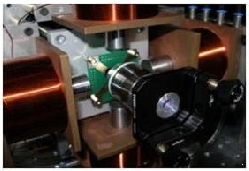Korean scientists identify mechanism of dimensional conversion
성수 최 2009-04-17 View. 13,975Monitor conversion from 2-dimensional and 1-dimensional characters in nano material
Korean scientists have identified dimensional conversion for the first time in the world.
The Ministry of Education, Science and Technology (Minister Ahn Byung-man) said on April 9 that a team of Korean scientists actually monitored dimensional conversion (critical phenomenon), in which the characters of a square (two dimension) and a line (one dimension) co-exist, through a study of characters according to sizes of nano materials, and identified for the first that that common rules exist in such conversion. The study was conducted by teams of researchers led by Prof. Choi Seok-bong at the department of physics and astronomy of Seoul National University, and Prof. Lee Hyun-woo at the department of physics of Pohang University of Science and Technology, which are supported by the program for supporting veteran researchers (formerly state-designated laboratory program) that is funded by the MEST and the Korea Science and Engineering Foundation.
The study, which scientifically demonstrated the crucial phenomenon of two physical situations (square, line) and then discovered common rules in such conversion, is a good example of the possibility for the existence of certain common rules in complicated biological and natural phenomena. Many scientists tried to identify such a phenomenon thus far, but failed in their attempts. As such, the study received high marks from the scientific journal, Nature.
The British scientific journal Nature lauded the study, saying that the study presents the first experimental evidence of high credibility that clearly answers questions many scientists have failed to answer. The journal called the study a "really excellent paper," which will make unique contributions to the development and application of diverse nano materials, including nano-spintronics, which will draw keen attention in the future."
The scientists monitored this conversion phenomenon through a study of characters according to the sizes of cutting-edge nano materials (less than approximately hundreds of nano meters (~100nm = 10-7m)), which are used in storage devices, including memories, in tune with dynamic development of ultra small, ultra high capacity, mobile electronic gadget technology. They were able to monitor the phenomenon using a scanning magnetic microscope, the world's only such measuring device that was designed and produced by the Korean scientists on their own.
The scanning magnetic microscope was created to monitor reaction of a material to external magnetic fields, and in the study, the device played a critical role in demonstrating that when the size of nano particles become increasingly smaller (two dimension) and reaches a certain tipping point, a new character or line (one dimension) emerges, instead of that of square.
The study is especially significant in that Korean scientists not only developed the device but also produced experimental agents, and conducted measurement and analysis on their own using homegrown technology.
Prof. Choi said, "This suggests that Korea's research base and researchers, which have been accumulating over the past years, have reached a world class, and demonstrates that the environment has been prepared in Korea for scientists to spearhead world-class research."

(Photo) Picture of internal core part of the scanning magnetic microscope.
ScienceTimes
Kim Chung-han
chkim at kofac.or.kr
[April 17, 2009]
- - - - - - -
Source - ScienceTimes

 Delete Article!
Delete Article!